Do you have a question about the HERO SPLENDOR i Smart and is the answer not in the manual?
Vehicle Identification Number (VIN) and Engine Number details.
Key vehicle dimensions, fluid capacities, and engine performance data.
Details on suspension, brakes, wheels, transmission, and steering geometry.
Information on battery, alternator, lights, indicators, and fuse.
Recommended actions and actions to avoid for safe riding.
Cautionary advice on using accessories and modifications safely.
Identification of key motorcycle parts via diagrams.
Explanation of instruments and indicators on the speedometer panel.
How to use the i3s system, including starting, driving, and indicator functions.
How the side stand indicator works and its switch.
Explains "ON", "OFF", and "LOCK" positions and key removal.
Operation of passing, headlamp, dimmer, turn signal, horn, and clutch switches.
Operation of starter switch, i3s switch, steering lock, and helmet lock.
Using the fuel valve and procedures for the fuel tank and cap.
Procedures for engine oil level checks, top-ups, and replacements.
Recommended tyre types, sizes, and air pressure for safe operation.
How to inspect tyres for wear, damage, and tread limits.
Checking air pressure and inspecting tubeless tyres for slow leaks.
Essential items to inspect daily before riding the motorcycle.
Step-by-step guide to start the engine safely.
Guidelines for smooth riding, running-in, and gear changes.
Proper braking methods and critical safety warnings.
Safe parking practices and tips to prevent motorcycle theft.
Operation of the utility box and contents of the tool kit.
Precautions before maintenance, hazards from exhaust, hot parts, and fire.
Steps to remove, clean, and reinstall oil filter screen and centrifugal filter.
How to inspect, gap, and replace the spark plug.
Procedure for removing and cleaning the air cleaner element.
Checking throttle play and importance of valve clearance.
Procedure for adjusting idle speed and cautions.
Adjusting clutch lever free play and inspecting the clutch cable.
Checking and adjusting drive chain slack and lubrication.
Adjusting front brake lever free play and checking wear.
Adjusting rear brake pedal free play and checking wear.
Battery maintenance, charging, storage, and fuse replacement procedures.
How to adjust the stop lamp switch for correct operation.
Checking side stand function and adjusting headlamp beam.
Inspecting suspension action and adjusting rear shock absorbers.
Procedure for removing the front wheel.
Procedure for removing the rear wheel.
Solutions for engine not starting due to fuel, starter, or spark issues.
Fixing engine stalling, poor pick-up, and electrical system faults.
Explains mandatory and cautionary traffic signs for rider safety.
Details on vehicle, battery, and emission warranty scope and limitations.
Vehicle Identification Number (VIN) and Engine Number details.
Key vehicle dimensions, fluid capacities, and engine performance data.
Details on suspension, brakes, wheels, transmission, and steering geometry.
Information on battery, alternator, lights, indicators, and fuse.
Recommended actions and actions to avoid for safe riding.
Cautionary advice on using accessories and modifications safely.
Identification of key motorcycle parts via diagrams.
Explanation of instruments and indicators on the speedometer panel.
How to use the i3s system, including starting, driving, and indicator functions.
How the side stand indicator works and its switch.
Explains "ON", "OFF", and "LOCK" positions and key removal.
Operation of passing, headlamp, dimmer, turn signal, horn, and clutch switches.
Operation of starter switch, i3s switch, steering lock, and helmet lock.
Using the fuel valve and procedures for the fuel tank and cap.
Procedures for engine oil level checks, top-ups, and replacements.
Recommended tyre types, sizes, and air pressure for safe operation.
How to inspect tyres for wear, damage, and tread limits.
Checking air pressure and inspecting tubeless tyres for slow leaks.
Essential items to inspect daily before riding the motorcycle.
Step-by-step guide to start the engine safely.
Guidelines for smooth riding, running-in, and gear changes.
Proper braking methods and critical safety warnings.
Safe parking practices and tips to prevent motorcycle theft.
Operation of the utility box and contents of the tool kit.
Precautions before maintenance, hazards from exhaust, hot parts, and fire.
Steps to remove, clean, and reinstall oil filter screen and centrifugal filter.
How to inspect, gap, and replace the spark plug.
Procedure for removing and cleaning the air cleaner element.
Checking throttle play and importance of valve clearance.
Procedure for adjusting idle speed and cautions.
Adjusting clutch lever free play and inspecting the clutch cable.
Checking and adjusting drive chain slack and lubrication.
Adjusting front brake lever free play and checking wear.
Adjusting rear brake pedal free play and checking wear.
Battery maintenance, charging, storage, and fuse replacement procedures.
How to adjust the stop lamp switch for correct operation.
Checking side stand function and adjusting headlamp beam.
Inspecting suspension action and adjusting rear shock absorbers.
Procedure for removing the front wheel.
Procedure for removing the rear wheel.
Solutions for engine not starting due to fuel, starter, or spark issues.
Fixing engine stalling, poor pick-up, and electrical system faults.
Explains mandatory and cautionary traffic signs for rider safety.
Details on vehicle, battery, and emission warranty scope and limitations.
| Displacement | 97.2 cc |
|---|---|
| Fuel System | Fuel Injection |
| Transmission | 4 Speed Constant Mesh |
| Front Suspension | Telescopic Hydraulic Shock Absorbers |
| Frame Type | Tubular Double Cradle |
| Seat Height | 785 mm |
| Engine Type | Air cooled, 4-stroke, Single Cylinder, OHC |
| Starting System | Self Start / Kick Start |
| Front Brake | Drum |
| Rear Brake | Drum (130 mm) |
| Rear Suspension | 5-step Adjustable Hydraulic Shock Absorbers |
| Fuel Tank Capacity | 9.8 L |
| Bore x Stroke | 50.0 x 49.5 mm |
| Clutch | Wet, Multi-plate |
| Front Tyre | 2.75 x 18 |
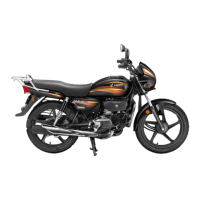
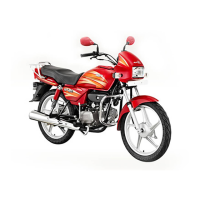
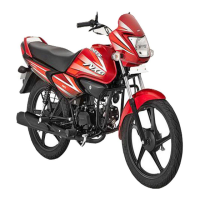
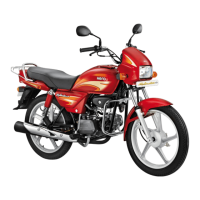
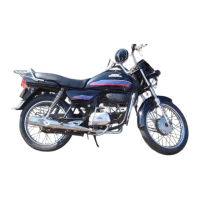
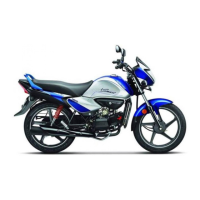
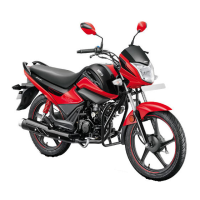
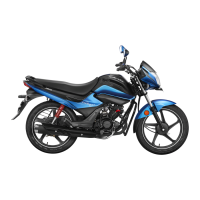
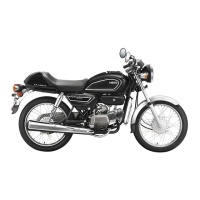

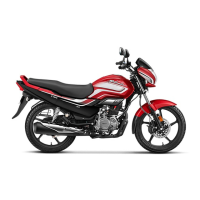
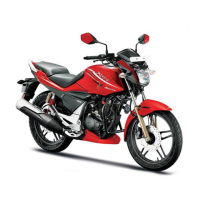
